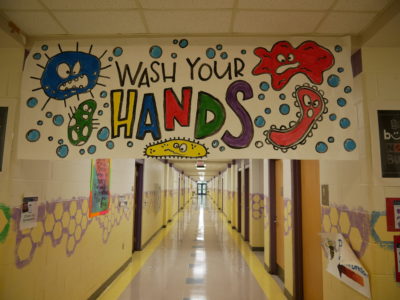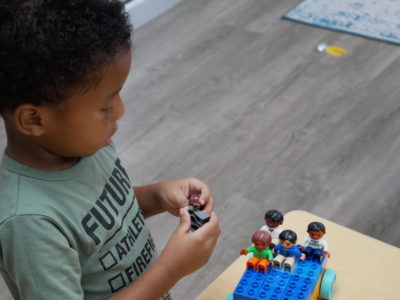|
|
As the COVID pandemic evolves, so do the factors influencing parents’ decisions. When it comes to young children specifically, information has shifted as scientists understand more about the coronavirus and its variants. In recent months, pediatric cases have risen as a share of overall cases, as have hospitalizations of young children.
EdNC reached out to Dr. Ibukun C. Kalu, medical director of pediatric infection prevention at Duke University Medical Center, to ask what this moment in the pandemic means for young children and their families. The following conversation has been edited for length and clarity.
EdNC: Parents have been navigating a lot of evolving information throughout the pandemic. From what we know right now, should parents, at this point, be thinking any differently about spread in young children?
Kalu: That might be a much broader question than our conversation allows us to get into, but I think the short answer is, not really. They certainly should be thinking about spread in terms of the viral variant — this variant is more transmissible — and in terms of the settings where kids are, and masking compliance in those settings. So what we know is, any household setting that has a COVID-19 infection or exposure usually leads to more secondary spread. To break that down: If your exposure occurs in the household where you live, you sleep, you do all your routine hygiene, you are more likely to acquire an infection in that setting as compared to the, for example, work setting, or school setting, where certain mitigation protocols are in place.
We also have a variant that has been shown to be increasingly more transmissible than other variants over the past year, and so we expect that in some settings, this particular variant, the delta variant, can spread a bit more. That translates down to kids, because our youngest kids are probably less likely to be wearing a mask — and we’re not necessarily recommending that for children less than 2 — and still require close contact care for the most part: being picked up, being put against someone’s chest, or maybe close to the face. And so it’s now on us as adults and older children to ensure that, in the settings where it’s applicable, we’re maintaining masking, or at the very least cleaning the environment and washing hands.
EdNC: Do you have advice for parents of young children when it comes to making sure their early learning settings — child care and elementary schools — are following appropriate safety measures?
Kalu: The only advice I would give would be to ensure there is awareness of what those measures are, and they fit with standard guidance, such as North Carolina Department of Health and Human Services (DHHS) or the Centers for Disease Control and Prevention (CDC). Most mitigation measures fall under the umbrellas of vaccinations, masking, cohorting — particularly for the younger ones — and then environmental cleaning.
(For a guide on the most recent DHHS guidance for K-12 schools, go here. For a training on updated DHHS guidance for child care providers, go here. Go here for CDC resources for families and children.)
EdNC: Should parents be worried about a rise in cases and/or hospitalizations for younger children?
Kalu: We can’t help but be worried. You’re absolutely right, we’ve seen a higher proportion of positive cases occur in children. And we’ve also seen more hospitalizations, particularly in the Southern regions that have had lower vaccination rates. So, as a pediatrician, as parents, as educators, as anyone that’s really following up on what’s going on in children, I think we’re all worried about this pattern, and are eagerly looking for ways to fix it.
Some of those are related to reducing their exposures, which may include physically where they go, what settings you put them into, but also just vaccination rates need to go up. That certainly still works, even in the context of seeing a highly transmissible virus and breakthrough infections.
EdNC: Do you know yet why we’re seeing a higher proportion of cases in younger children and higher rates of hospitalization in younger children?
Kalu: We have a more transmissible virus, affecting both vaccinated and unvaccinated people. And right now, the group that is ineligible for vaccinations still is our youngest kids, so less than 12. Presumably, if we’re going to see high rates within the community, it will translate over time to higher rates in younger kids. It’s not unexpected to see that.
We don’t know enough yet about severity and how the virus has changed in terms of how the receptors in younger children are reacting to the virus, so I think some of the biochemical properties will take time for us to understand. Before now, higher rates would translate to a higher number of cases across all age groups. And unfortunately, in some groups, we will see more hospitalizations, more severe outcomes, and eventually we’ll start to see higher rates of death.
EdNC: Is there anything else that you’d like to add as far as parents with young children making the best decisions that they can about their children’s health right now?
Kalu: We still see patterns that suggest that children may be less efficient at spreading SARS-CoV-2, the virus that causes COVID-19. But, unfortunately, we’ve seen a slight change in the patterns of infections and hospitalizations. So kids can get infected, can spread to each other, spread to adults, and unfortunately they can get really sick from this.
The only thing I’ll add is that, in addition, we’ve seen other respiratory viruses that lead to several severe respiratory infections occur almost in tandem with the delta surge, and so that complicates things for parents that are managing younger kids. We’re just trying to understand what virus could potentially be causing the ongoing symptoms, and what they should do. Reach out to your provider. Get kids tested if they have symptoms you’re worried about. For adults or older kids that are eligible for vaccinations, ensure they get vaccinated. And, at least for now, ensure that those that can, should wear masks in crowded spaces and outside the home.





